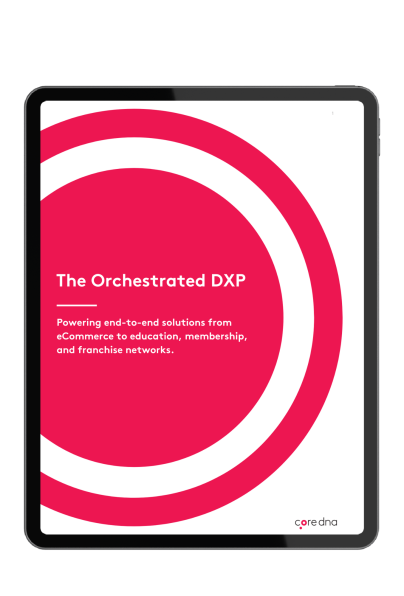Orchestration: The Missing Link for Most CMS and eCommerce Platforms

Most CMS and commerce platforms promise flexibility, but when it's time to integrate tools, automate logic, or respond to customer events in real time, most of them fall flat. Developers get overloaded, workarounds pile up, plugins break under pressure, and operational teams are left chasing manual processes.
That’s why we didn’t just add automation to Core dna, we reimagined it.
We built an orchestration engine, native to the platform, to give businesses the power to automate intelligently, integrate without friction, and control business logic at scale. This wasn't an afterthought. It was a strategic move.
As we outlined in our Beyond Automation blog post, orchestration is not just about saving time, it's about scaling smarter. It's what connects your commerce logic with your content workflows, your ERP systems with your storefront, and your marketing with your operations.
Orchestration is how modern businesses run end-to-end without duct tape.
Key takeaways
- Core dna includes a native orchestration engine that connects systems, automates logic, and empowers teams without third-party tools.
- From marketers to operations leads, anyone can create workflows, launch campaigns, or sync data
- Core dna enables brands to build internal apps, run approval flows, sync ERPs, and power complex fulfillment logic, all within the platform.
- Whether you're running a franchise, B2B network, membership org, or global brand, Core dna supports localized workflows with centralized control.
On this page:
How Orchestration Supercharges Core dna
(and Why We Built It)
Orchestration is Core dna’s native logic engine a system that lets businesses define how things should work across content, commerce, and backend systems, all without relying on third-party automation tools or complex development cycles.
Unlike typical automation add-ons, Core dna’s orchestration engine is deeply embedded in the platform. That means workflows aren’t bolted on, they're built in.
This native approach enables even non-technical users to build powerful automations, integrations, and internal tools without writing a single line of code. Through a visual interface, teams can connect logic blocks, create branching workflows, and even develop lightweight apps that trigger orchestrations based on user actions all within the Core dna admin.
It’s not just about automating repetitive tasks. It’s about giving your marketing, operations, and product teams the ability to design real logic into how the business runs. Whether it’s syncing inventory, sending transactional emails, provisioning content, or triggering AI workflows. Core dna gives teams the autonomy to move faster without waiting on dev queues.
Here’s what makes orchestration powerful:
- Responds to real-time events (like form submissions, order confirmations, or entity updates)
- Runs scheduled jobs (every minute, hour, or day)
- Accepts external webhooks from third-party tools
- Executes user-driven actions via custom apps and admin tools
Orchestration acts as the brain of your digital operations by connecting data, systems, and people without requiring code or plugins.
How Orchestration Works in Core dna
At its core, orchestration in Core dna isn’t just about creating workflows, it’s about enabling teams to build true business applications that enhance productivity and eliminate manual steps.
Because it’s built directly into the platform, orchestration understands the context of your CMS, your eCommerce engine, and every piece of data flowing through your system.
You’re not stitching together external tools or waiting on development teams. You’re building the logic that makes your business run visually, natively, and instantly.
In the video above, you can see how we can create an app with orchestration that lets a brand manager select a franchisee and bulk-provision products, and automatically trigger orchestrations to create categories, apply SEO metadata, and notify teams, all from a clean admin interface. No dev tickets. No middleware. Just business logic that works.
This is what orchestration brings to Core dna: the power to build apps that match your internal processes, whether it's provisioning, syndication, syncs, or approvals, and run them as part of your platform, not as bolt-ons or afterthoughts.
Here’s what makes orchestration in Core dna a business game-changer:
- HTTP Requests: Seamlessly connect with external systems like ERPs, CRMs, payment gateways, or marketing tools. These calls can push or pull data in real-time.
- Record Operations: Create, update, or delete entries across your content or product catalog without ever touching the backend.
- Execute Templates: Run dynamic business logic that adapts to context—like different pricing models, user types, or regions.
- Email Notifications: Automatically notify customers, internal teams, or vendors as part of your process flow.
- Conditions & Branching: Build smart decision logic that adapts your workflow based on specific conditions or triggers.
What makes this revolutionary is that it's not reserved for IT teams. A marketer can launch a flash sale campaign that triggers personalized emails, adjusts product visibility, and logs actions, all through a visual interface. A brand manager can provision products to new stores and set up approval workflows.
A content lead can syndicate localized assets to different regions. All of this happens inside the CMS + commerce interface, without writing code.
This is the future of how digital operations are run: no plugins, no middleware, just fully integrated orchestration that's as intuitive as it is powerful.
Industry Applications of Orchestration
Orchestration in Core dna isn’t just powerful—it’s practical. Different industries face different operational challenges, and orchestration gives them the flexibility to solve those challenges without complex custom development. Here’s how organizations across sectors are putting it to work:
Franchise & Retail Networks
- Automatically sync product data and pricing across multiple store locations
- Enable local stores to customize promotions while maintaining brand control
- Trigger store-specific fulfillment workflows and notifications
B2B & Manufacturing
- Automate complex quote approvals, contract logic, and tiered pricing structures
- Sync data between CRM, ERP, and product catalogs
- Provision partner portals and custom workflows with minimal IT support
Membership Organizations
- Manage member access rights across content and digital tools
- Automatically trigger renewals, reminders, and onboarding sequences
- Personalize content delivery based on member tiers or engagement
Global & Multi-Brand Enterprises
- Deploy localized content and product data across regional sites
- Automate translation workflows, compliance notices, and SEO metadata
- Coordinate cross-brand campaigns from a single interface
Agencies & Platform Builders
- Build and reuse internal tools or client apps directly within Core dna
- Connect external APIs without building middleware
- Offer value-added services like automated reporting or syndication engines
These examples only scratch the surface. Orchestration adapts to your structure, your tools, and your workflow—bringing real-world efficiency to industries with real operational complexity.
Unlocking Orchestration Value Across Teams
Orchestration empowers entire organizations. With logic-building capabilities available inside the Core dna admin, every team gains new superpowers to streamline operations, automate tasks, and build better experiences. Here’s how different roles benefit:
Executives & Operations Leaders
These decision-makers are often stuck between high-level goals and disconnected systems. Orchestration gives them oversight and agility without developer dependence.
- Gain visibility and control over business logic without needing technical intervention
- Replace spreadsheets, siloed tools, and manual tasks with automated, traceable workflows
Marketing & Content Teams
Creative teams need to move fast but are often slowed by dev requests. Orchestration empowers them to automate content actions and campaigns independently.
- Trigger dynamic content delivery, automate campaign actions, and personalize user journeys.
eCommerce Managers
Tasked with pricing, fulfillment, and promotions, eCommerce managers thrive with workflows that respond to customer behavior and market shifts in real time.
- Manage inventory sync, pricing updates, shipping logic, and promotions with workflows that adapt to region, language, and customer type
IT & Dev Teams
Instead of handling every request, devs can now build core components and let teams manage their own workflows.
- Offload repetitive tasks with business-owned logic, while retaining the flexibility to connect deeper integrations when needed
Agencies & Partners
For those building on behalf of others, orchestration means faster launch cycles, easier maintenance, and more value-added services—all inside the platform.
- Rapidly prototype internal tools, apps and storefront customizations, or client workflows, directly inside the Core dna platform
The Bottom Line
If your team is still stitching systems together with fragile plugins or relying on manual workarounds to get things done, you're not just inefficient, you're falling behind.
Orchestration is the missing layer in most CMS and commerce platforms. It’s what turns a good platform into a great one that is intelligent, agile, and deeply connected to how your business actually operates.
With Core dna, you're not just managing content or selling products. You're building a digital backbone that adapts, automates, and scales with you.
This isn’t a plugin. It’s your platform’s brain designed to orchestrate every part of your operation.





